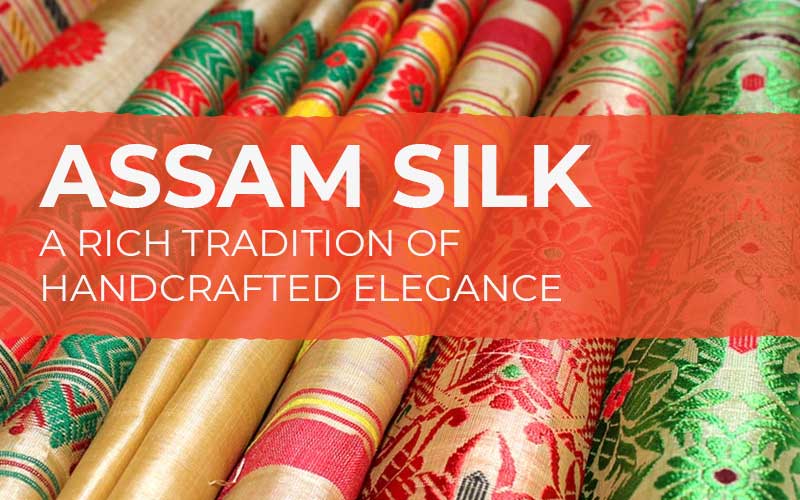
Assam Silk: A Rich Tradition of Handcrafted Elegance
Assam silk is a type of silk that is indigenous to
the northeastern Indian state of Assam. It is produced by the larvae of a
species of silkworm which is native to the region. The quality, durability, and
unique texture of Assam silk make it highly prized.
The production of Assam silk is a labor-intensive
process that involves several stages. It begins with the cultivation of the
silkworms, which are raised on a diet of specific leaves, mainly Som
(PerseabombycinaKost.), formerly named as Machilusbombycina (King ex Hook. f.)
and Soalu (LitseamonopetelaRoxb.= polyantha Juss.) and few other food plants,
likewise Digloti (Litsaeasalicifolia Hook), Mejankari (LitsaeacubebaLour.),
Bogori (Zizyphusjujuba Mill), Champa (Micheliachampaca Linn.), Bhomloti
(Symplocousgrandifolia Wall.), Patihonda (Actinodaphnaeobovata Blume), Gamari (Gamelinaarborea
Linn.) Panchapa (Magnolia sphenocarpaRoxb.), Katholua
(CyclicodaphnenitidaRoxb.), Gansarai (CinnamomumglanduliferumMeissu), Bojramoni
(Xanthoxylumrhesta DC.). After the larvae have spun their cocoons, the cocoons
are collected and boiled to kill the silkworms inside. This process is known as
'sericulture.'
Once the cocoons have been boiled, the silk is
extracted by hand. The process of hand-extracting the silk requires great skill
and patience. The extracted silk is then spun into yarn and woven into the
fabric using traditional handlooms.
Assam silk comes in several different varieties,
each with its own unique texture and design. Some of the most popular types of
Assam silk include Muga silk, Pat silk, and Eri silk.
Muga Silk:
Muga silk is a golden-yellow silk that is known for
its durability and luster. It is produced by a specific type of silkworm, the
Antheraeaassamensis, which is native to Assam. It is considered to be one of
the most expensive types of silk in the world and is often used to make
high-end clothing, such as sarees and shawls. In Assamese culture, Muga silk is
often worn during special occasions like weddings and festivals. Muga silk is
highly valued for its durability and is often passed down through generations
Pat Silk:
Pat silk, also known as Mulberry silk, is a soft,
lightweight silk that is commonly used to make scarves, stoles, and other
accessories. This type of silkworm predominately feeds on mulberry leaves. Pat
(mulberry) silk is available in a range of colors and designs and is often
adorned with intricate embroidery or other embellishments.
Eri Silk:
Eri silk, also known as Endi silk or Errandi silk,
is a silk that is produced by the caterpillar of the Eri moth. Unlike other
types of silk, the cocoons of the Eri moth are not boiled to extract the silk,
which makes Eri silk an eco-friendly alternative to other types of silk. That’s
why it is also known as Ahimsa silk or peace silk. Eri silk is soft,
breathable, and often used to make warm, comfortable clothing, such as shawls
and jackets.
Assam silk has
a rich history and is deeply intertwined with the culture and traditions of the
region. It is often used to make traditional clothing, such as sarees and
mekhela chadors, which are worn by women in Assam. Assam silk is also used to
make a range of other products, such as bags, cushion covers, and home decor
items. These are an important part of the state's rich textile tradition and
continue to be produced and cherished by artisans and consumers alike.
In recent years, the production of Assam silk has
faced several challenges, including competition from synthetic fabrics and
declining demand for traditional clothing. To address these challenges, several
initiatives have been launched to promote the use of Assam silk and to support
the livelihoods of the weavers and artisans who produce it.
The culture and traditions of Assam are deeply
rooted in the production of Assam silk, which is one of the most valuable and
unique products in the world. It is a testament to the skill and artistry of
the weavers and artisans who produce it and is a source of pride for the people
of Assam.
The silk varieties of Assam are important to the
local economy in addition to their cultural significance. There are many rural
artisans in Assam who earn a living through silk weaving. Several initiatives
have been taken by the state government to promote and support the silk
industry, including the establishment of silk production centers and the
training of weavers.
Disclaimer: The opinions expressed in this article are those of the author's. They do not purport to reflect the opinions or views of The Critical Script or its editor.

Newsletter!!!
Subscribe to our weekly Newsletter and stay tuned.

















Related Comments